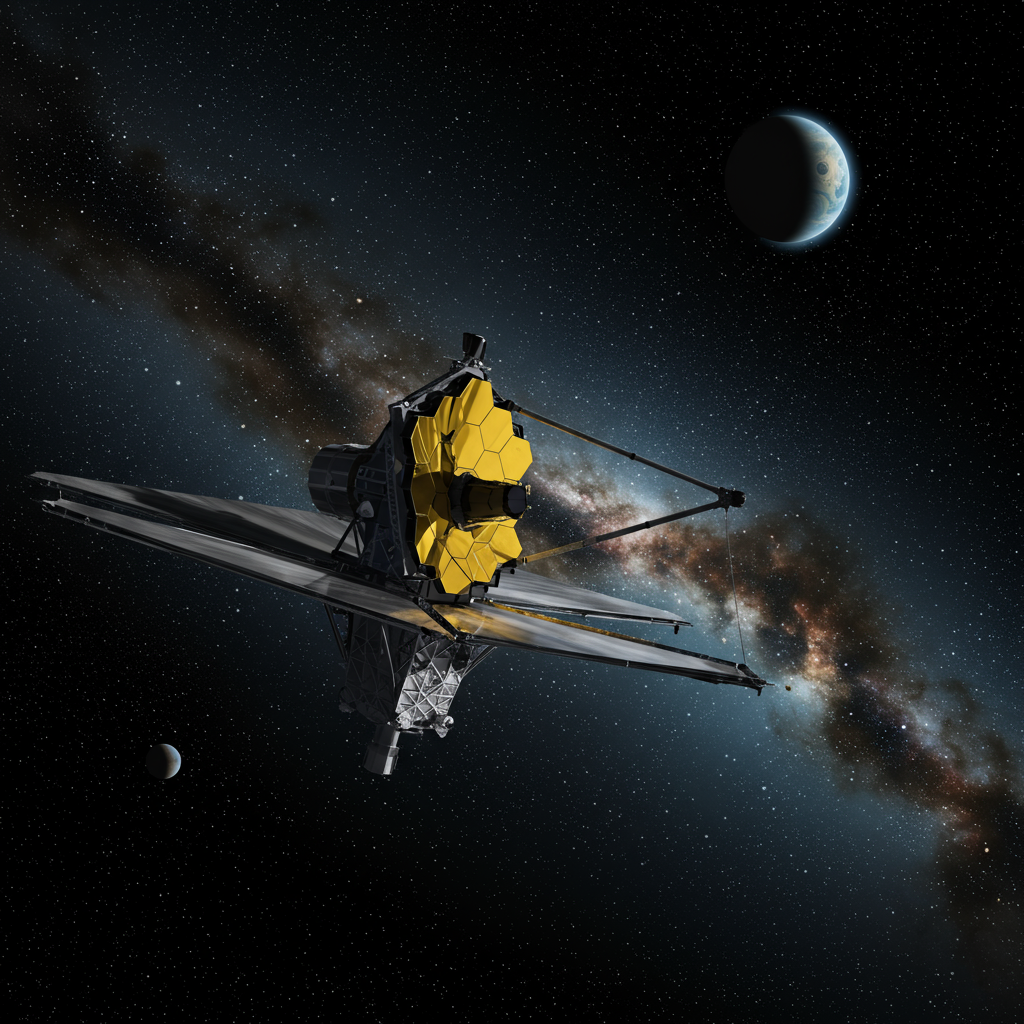For generations, humanity has gazed at the stars, asking one of the most profound questions: Are we alone in the universe? Recent findings using the powerful James Webb Space Telescope (JWST) are bringing scientists closer than ever to potentially answering that question. A team of astronomers has detected intriguing chemical signatures in the atmosphere of a distant exoplanet, K2-18b, that could be linked to biological activity – the strongest hint yet of possible life beyond Earth. Located some 124 light-years away in the constellation Leo, this “hycean” world is emerging as a prime candidate in the cosmic search for extraterrestrial life.
The focus of this excitement is K2-18b, a planet significantly different from our own. It’s classified as a “sub-Neptune,” meaning it’s larger and more massive than Earth but smaller than gas giants like Neptune. Specifically, K2-18b boasts a mass about 8.6 times Earth’s and a radius 2.6 times larger. This size profile, common throughout the galaxy but absent in our solar system, suggests its interior likely contains a vast mantle of high-pressure ice. Crucially, K2-18b orbits within the habitable zone of its star – often called the “Goldilocks zone” – where temperatures could potentially support liquid water on a planet’s surface.
Unlocking Atmospheric Secrets with Webb
The key to these potential discoveries lies in analyzing the light from K2-18b’s star as it filters through the planet’s atmosphere during a transit (when the planet passes in front of its star). This method allows astronomers to decipher the atmosphere’s chemical makeup. Using the James Webb Space Telescope’s sensitive instruments, researchers led by Prof. Nikku Madhusudhan at Cambridge University have taken this technique to a new level.
Previous observations with the Hubble Space Telescope in 2019 hinted at the presence of water vapor on K2-18b. Building on this, JWST investigations in 2023 detected carbon-bearing molecules, including methane and carbon dioxide, for the first time in the atmosphere of a habitable-zone planet. These findings supported the hypothesis that K2-18b might be a “hycean world” – a theoretical planet type with a massive hydrogen-rich atmosphere potentially blanketing a vast liquid ocean. The absence of ammonia in earlier data also supported this, suggesting it might be dissolved in water.
The Intriguing Signal: Dimethyl Sulfide (DMS)
The most compelling recent finding, however, involves the possible detection of sulfur-based gases, specifically dimethyl sulfide (DMS) or dimethyl disulfide (DMDS), or perhaps both. On Earth, DMS is overwhelmingly produced by biological processes, primarily marine phytoplankton and bacteria. Its detection in the atmosphere of K2-18b, a planet believed to potentially harbor extensive oceans, is highly significant. The estimated concentration of this gas on K2-18b appears thousands of times higher than typical levels found in Earth’s atmosphere.
The initial hint of DMS was weak in the 2023 data. However, follow-up observations with a different JWST instrument sensitive to different wavelengths provided a stronger, though still relatively weak, signal. Detecting a consistent signature across multiple instruments strengthens the possibility that the chemical is indeed present. Prof. Madhusudhan stated that these represent the “first hints” of a potentially inhabited alien world, describing it as a “revolutionary moment.”
Why Scientists Remain Skeptical (For Now)
Despite the undeniable excitement, the scientific community emphasizes the need for rigorous caution and further verification. The detection of DMS currently stands at a “three sigma” level of certainty (99.7%). While this is a substantial improvement over previous results (which were only “one sigma,” or 68% certainty), it falls short of the scientific standard for a formal discovery, which requires “five sigma” certainty (99.99999% certainty).
Achieving five-sigma confirmation is the crucial next step, and researchers are optimistic that additional JWST observations over the next year or two can provide the necessary data. However, even a statistically confirmed detection of DMS would not definitively prove the existence of life. Scientists must painstakingly evaluate and rule out all potential non-biological processes that could theoretically produce these molecules in K2-18b’s unique environment.
Alternative explanations for K2-18b’s composition also fuel scientific debate. While the “hycean” model is favored by some, others suggest it could be a mini gas giant with no surface or even have an ocean of molten rock, scenarios that would preclude life as we know it. Collaborative efforts are underway to investigate non-biological pathways for DMS/DMDS formation in laboratory settings, mimicking the potential conditions on K2-18b.
K2-18b in the Broader Search for Life
The potential detection of biosignatures on K2-18b marks a significant milestone in the ongoing search for life beyond Earth. While searches continue within our own solar system – looking for past life on Mars or exploring subsurface oceans on moons like Jupiter’s Europa – the sheer number of exoplanets in the Milky Way (estimated in the trillions) suggests that the best opportunities for finding life may lie outside our solar system.
Worlds like K2-18b – hydrogen-rich, potentially ocean-covered, and within their star’s habitable zone – are now priority targets for investigation. The JWST, with its unprecedented capabilities to analyze exoplanet atmospheres, is a game-changer in this field. This discovery highlights the telescope’s potential to identify chemical clues that could point to alien ecosystems, even if they are microbial in nature, similar to Earth’s phytoplankton.
If confirmed, these findings could fundamentally alter our understanding of the prevalence of life in the cosmos. As Prof. Madhusudhan noted, a confirmed detection could be a moment when the “living universe came within reach,” potentially implying that life is “very common in the galaxy.” However, as other scientists caution, this is part of a much larger, ongoing effort to understand what lies beyond our planet, requiring patience, further data, and rigorous scientific scrutiny. The path from potential hint to definitive proof is long, but the journey itself is revolutionizing astrobiology.
Frequently Asked Questions
What is Dimethyl Sulfide (DMS) and why is its potential detection on K2-18b important?
Dimethyl sulfide (DMS) is a chemical compound that, on Earth, is produced almost entirely by living organisms, particularly marine microbes like phytoplankton. Its potential detection in the atmosphere of K2-18b is significant because it could serve as a “biosignature” – a chemical hint suggesting the presence of life. Since K2-18b is thought to potentially have a large ocean, finding a molecule strongly associated with marine life on Earth is particularly exciting, although non-biological sources must still be ruled out.
Where is the exoplanet K2-18b located and what are its characteristics?
K2-18b is an exoplanet situated approximately 124 light-years away from Earth in the constellation Leo. It orbits a red dwarf star and resides within its habitable zone, meaning it’s at a distance where liquid water could potentially exist on its surface. K2-18b is significantly larger and more massive than Earth, with about 8.6 times the mass and 2.6 times the radius, placing it in the “sub-Neptune” category. Scientists propose it may be a “hycean world” – a rocky core covered by a vast ocean, wrapped in a deep, hydrogen-rich atmosphere.
Can scientists definitively confirm the presence of life on K2-18b based on current data?
No, scientists cannot definitively confirm the presence of life on K2-18b yet. The detection of potential biosignatures like DMS is currently at a “three sigma” certainty level (99.7%), which is not the standard for a formal scientific discovery (requiring “five sigma” or 99.99999% certainty). More observations with the James Webb Space Telescope are needed to reach this higher confidence level for the chemical detection. Furthermore, even if the presence of DMS is confirmed, researchers must thoroughly investigate and rule out all possible non-biological explanations for its existence in K2-18b’s unique environment before attributing it to life.




